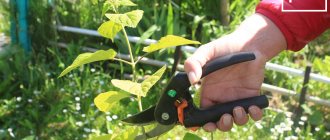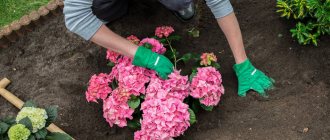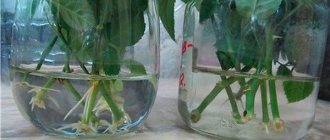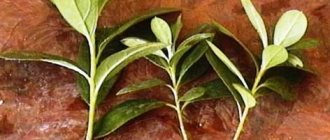Propagate beautiful hydrangeas for free in a couple of weeks in 2 easy steps! Start rooting plants with the secret to trouble-free propagation!
An easy way to multiply your favorite hydrangea varieties: propagate the plant by cuttings! Like many amateur gardeners, you can never have enough hydrangeas as they come in so many different shapes and shades!
Hydrangeas are a perennial favorite in English gardens and farmlands! Hydrangeas make a great gift for friends who love growing flowers!
Each of us can purchase 50 varieties of hydrangea or exchange with gardening friends and propagate hydrangeas by cuttings at home!
All types of hydrangeas, from the spectacular bigleaf hydrangea (Hydrangea macrophylla) to the delightful tree-like hydrangea (Hydrangea arborescens), are easy to propagate. Cuttings propagated last summer begin to bloom next year!
Reproduction methods
If you choose the optimal time and conditions for the propagation of hydrangia, the young bushes will quickly take root. Propagating hydrangeas is not easy. This requires knowledge, patience, attention and time.
The following methods will help with autumn plant propagation:
- cuttings in September;
- dividing a bush with good protection before winter frosts;
- layering in early autumn;
- young shoots (babies).
It is better to grow hydrangea from seeds in the spring. This method requires more care and effort. But even an inexperienced gardener can cope with other methods.
Deadlines
Frost-resistant hydrangea can be propagated on the site both at the beginning of the growing season and at its end. The plant quickly takes root in the soil and tolerates cold well. Despite this, it is necessary to choose the right timing for reproduction.
On average, the culture takes about 3-4 weeks to take root. It is recommended to carry out any work on growing shrubs from the beginning of September to the beginning of October. If you start the propagation procedure too late, the plant may suffer from the first frost.
The large-leaved variety begins to reproduce first, since it does not tolerate cold well.
How to propagate hydrangea from cuttings
If you cut hydrangea in September, you will have to plant it in containers. Further care is carried out at home. But spring or summer cuttings can be rooted directly in open ground.
Important! When cutting cuttings, choose only healthy shoots. Specimens with signs of disease, damage, or pests are not suitable for cuttings.
How to select and prepare cuttings
Half the success will be if you cut the workpieces correctly. It is better to approach this event in the morning or in cloudy weather. For cuttings, use only one-year-old shoots that have not yet become woody. Your assistant in this matter will be a pruning shear or garden shears. Cut the selected shoots obliquely at a distance of 10–15 cm from the top. Remove the lower foliage, leaving only the upper leaves and buds. Cut the remaining sheets in half.
How to propagate hydrangea by cuttings in water
Do not leave harvested hydrangia cuttings without water even for a little while. As soon as you cut them, immediately place them in water or in a pre-prepared solution with a rooting agent. It is better to do this in a transparent glass jar. Root formation stimulators “Kornevin”, “Zircon”, “Heteroauxin” are suitable for this. Dip the cuttings into the solution so much that the upper leaves do not touch the liquid.
Place the workpieces in a bright place, because the formation of roots will depend on this. If you do not have a rooting agent, then use 1 tsp. honey. Change the water in the jar every other day so that it does not become musty. After 3-4 weeks, the cuttings will produce roots up to 2 cm in length.
How to root hydrangea with cuttings in the soil
Propagation by cuttings in the ground is often used. To do this, first place the workpieces in a root formation stimulator for a day. For rooting, use a mixture of peat and sand in a 2:1 ratio or buy a special earthen composition. If you have a lot of cuttings, tie them together in 4 pieces. Deepen the blanks into the prepared substrate to a depth of 5 cm. Spray the seedlings with a spray bottle for a couple of days in a row.
Did you know? The most frost-resistant umbrella hydrangea. It was named so because of the small flowers collected in inflorescences in the form of an umbrella. It also lasts longer than other hydrangeas in water when cut.
Cover the cuttings with glass jars or clear plastic cups . Open them every 5-6 days for ventilation. Remove the caps completely when the cuttings take root. After this, you can plant the seedlings in separate pots and wait until spring, when they will be planted in open ground.
Which breeding method is better?
Each method of growing hydrangeas requires effort. Cuttings are considered the most common and successful. But many gardeners use a method that combines rooting layering and cuttings, without requiring much effort or skill. We proceed like this:
- We put potted hydrangea in the garden for the summer. During the season, it manages to gain strength and develop a root system.
- At the beginning of September, we remove all leaves and young immature shoots from the flower.
- We take it out of the pot and place the entire bush in soft soil so that the roots are below the stems, but all the branches are completely immersed in the ground.
- Sprinkle the rhizome, compact the soil, and water it.
- We fan out the branches, each one separately, and also cover it with earth.
- We water the garden bed very well.
In the spring, as many new hydrangeas will sprout from the bush as there were buds on the branches.
Before planting, we thoroughly clean the bush of foliage and young shoots, otherwise they may rot and spoil the entire plant.
How to propagate by dividing a bush
The easiest way to propagate in the fall is to divide the bush into several parts. Spring replanting has less impact on the condition of the divisions, while autumn replanting requires careful protection from frost. This must be done before the third ten days of September so that they are sufficiently rooted and strengthened.
Find out more about how to care for hydrangeas in the fall.
How to divide a bush correctly
For division, choose a large shrub. Dig it carefully around a circle with a radius of 50 cm. It is better to use a pitchfork for this, then you will damage the roots of the plant less. Carefully inspect the condition of the bush, pay attention to signs of disease and damage. If you need to divide the root system into more than two parts, then make sure that there are at least 2 renewal buds on each division.
How to plant after dividing a bush
Sprinkle the damaged ends of the roots with charcoal or soak them in green paint. Prepare the holes for transplantation, fertilize them with a mixture of compost, peat and mineral fertilizers. Cover the resulting parts with soil, water, and add peat or sawdust mulch.
Peculiarities of propagation of different types of hydrangea
In order to properly grow hydrangea in the fall from cuttings, cuttings or divisions, it is necessary to take into account the characteristics of a particular variety. The propagation of large-leaved, tree-like or paniculate shrubs has its own nuances.
How to propagate large-leaved hydrangea in the fall
To propagate large-leaved hydrangea in the fall, you can use each of the listed methods. The shrub germinates well from cuttings, layerings and divisions, quickly takes root in the soil and blooms profusely the following year.
When using any method, it is necessary to take into account that large-leaved hydrangea has low frost resistance. It needs to be propagated in early autumn, all work must be completed no later than the end of September, otherwise the bush will not have time to take root and will suffer from frost. For the winter, the plant is covered with special care with non-woven materials and spruce branches, and then, if possible, the seedlings are insulated with fallen snow.
Reproduction of tree hydrangea in autumn
To propagate tree hydrangea, it is recommended to use cuttings or root green layering from the lower part of the bush. The variety reacts poorly to division, recovers with difficulty, takes a long time to take root in a new place and subsequently may not bloom for a couple of years.
Tree hydrangea cuttings can be carried out in the fall until mid-October. Although the variety is highly frost-resistant, young seedlings react negatively to cold weather. For the winter, plants must be carefully covered with spruce branches to ensure high-quality protection of the root system and above-ground parts.
How to propagate paniculate hydrangea in autumn
A peculiarity of propagation of paniculate hydrangea is that when growing shrubs it is not recommended to use the division method. The plant must be reproduced by cuttings or layering; they take root well in the soil and demonstrate high endurance.
It is not recommended to postpone propagation of paniculate hydrangea until late autumn. For propagation, green shoots are needed, and young branches of the bush become woody very quickly. Therefore, all work must be carried out at the end of summer or before mid-September. It is recommended to cut the lower shoots that lack flower buds for cuttings.
The first three years after breeding, paniculate hydrangea needs careful covering for the winter.
How to properly propagate by layering
In autumn, it is appropriate to make seedlings from cuttings. Carry out a similar procedure after the inflorescences have faded. You can combine this process with covering the hydrangea for the winter. By spring, each sprinkled branch will give rise to a young rooted plant. Do not use woody shoots for this method.
Did you know? If you brought home a bouquet of hydrangia inflorescences from your dacha, you can revive it with citric acid on the tip of a knife. It is enough to add it to a vase with water.
Then follow this plan:
- Carefully loosen the soil around the bush, but do not damage the root system.
- Level the ground.
- Make several grooves (1.5 cm deep), depending on how many branches you need to root.
- Lightly cut the bark on the cuttings in places that will come into contact with the soil in a circle with a knife and treat with a rooting stimulator.
- Press each stem well to the ground where the grooves are located.
- Sprinkle them with soil and place a small stone on top to secure them.
- Make sure that the top of the cuttings is as vertical as possible to the soil. To do this, you can tie it to a peg.
- In dry weather, you can water the places where the branches touch the ground.
- When you do this procedure at the end of September, the cuttings will take root by the end of October. It’s even better to leave them in this position until spring.
If you are new to growing hydrangia, then this breeding method will suit you best.
Caring for hydrangea after division
Dividing a hydrangea bush in the fall has a significant advantage over doing work in the spring. Almost no maintenance is required for the transplanted bush. Only in the dry months do you need to water the young bushes once a week so that they grow better.
Hydrangea does not like waterlogging; in such an environment its roots quickly rot. To prevent trouble, no more than 10 liters of water should be poured under each bush. There is no need to carry out any other work until spring.
If autumn turns out to be dry, you can water the plant once every 2-3 days.
Replanting an adult bush
In order to successfully transplant a strong bush to a permanent place in the fall or move an already mature plant, you need to perform the following steps:
- In the spring, we dig a trench around the plant to the depth and width of a shovel. The diameter of the above-ground part of the plant corresponds to the width of the roots.
- We pour compost into the trench. Over the summer, the roots will begin to fill the compost layer.
- At the same time, we are preparing a hole in advance where the hydrangea will move in the fall. We dig a hole into which we fill with sand, humus and peat.
- In the fall, the day before moving, water the plant and the new hole well.
- Place bricks, pebbles or stones at the bottom of the hole.
- We prepare an earthen mixture consisting of two parts humus, two parts earth, one part sand and one peat.
- We dig around the bush around the compost and take out the trunk along with a lump of earth.
- We place the plant in the hole at the same depth at which it grew before.
- Water generously.
Hydrangea needs to be planted to such a depth that the root collar is in the ground - the place where the trunk turns into the root.
So, choosing the most successful method for propagating hydrangeas depends on your plant:
- If you have an adult healthy bush, then you can use the method of dividing the bush, cuttings or layering.
- If the plant is not yet fully grown, try cuttings.
- If you notice a good shoot at a decent distance from the mother plant, feel free to use seedlings.
- If you were given a young hydrangea in a pot, propagate it by deepening the entire bush.
- If you don’t have hydrangea yet, and the funds don’t allow you to buy it, try to sprout it from seeds.











